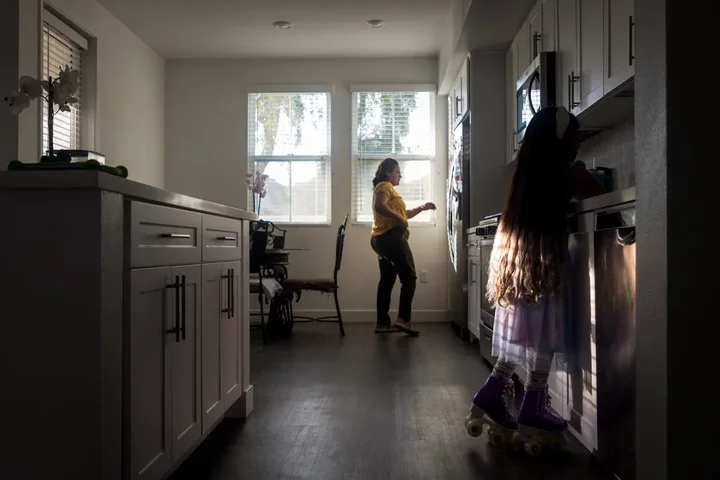California Is Giving Schools More Homework: Build Housing for Teachers


Report: Converting School Surplus Property into Housing
Carolina Sanchez Garcia cooks with her daughter, Berthalinda Hernandez, 6, at their home in San Diego on Aug. 7, 2024. Sanchez Garcia, who teaches preschool, was able to move into San Diego Unified School District housing in December. Photo by Zoë Meyers
Introduction
In a flurry of recent legislation and initiatives, California officials are pushing school districts to convert their surplus property into housing for teachers, school staff, and even students and families. Some districts have already started; now the state wants every district to become a landlord.
Sustainable Development Goals (SDGs)
- Goal 4: Quality Education
- Goal 11: Sustainable Cities and Communities
- Goal 17: Partnerships for the Goals
State Superintendent’s Vision
State Superintendent of Public Instruction Tony Thurmond believes that California has the resources and ingenuity to solve the housing shortage. He emphasizes that California’s schools have the land to make this happen and calls on school leaders to restore the California Dream for their communities.
Skepticism and Concerns
Despite the vision presented by Thurmond, some superintendents and education analysts are skeptical. They argue that not all districts will be able to successfully implement housing projects and that school districts should focus on education rather than real estate development. Mendocino County Superintendent Nicole Glentzer expresses concern about the increasing responsibilities placed on educators and believes that the housing crisis is too much to handle alongside other challenges.
Legislation and Financial Incentives
Last month, Thurmond pledged financial incentives for districts that pass bonds to build staff housing. The Department of Education is also sponsoring a workshop for district officials to learn about real estate development. These initiatives follow previous legislation, such as the Teacher Housing Act of 2016, which allows school districts to pursue funding sources for housing projects. Other laws have streamlined the development and funding process.
Available Land and Potential Impact
A report from UC Berkeley and UCLA reveals that school districts in California own 75,000 acres of developable land, enough to build 2.3 million housing units. This could potentially eliminate the state’s housing shortage. Proposition 2, a $10 billion school facilities bond, could provide funding for building teacher housing if it passes.
Successful Projects
Several districts have already embarked on housing projects. Los Angeles Unified, San Francisco Unified, and Santa Clara Unified are among the districts that have built or plan to build housing units for teachers and low-income families. Other districts, such as San Mateo County and Marin, have partnered with housing nonprofits and government entities to provide affordable housing for teachers.
Positive Impact on Teachers and Students
Teachers who have benefited from these housing initiatives express gratitude for the positive changes in their lives. Carolina Sanchez Garcia, a preschool teacher in San Diego, shares how her commute time has significantly reduced, allowing her to spend more time with her children and feel more energized. Kyle Weinberg, president of the San Diego Education Association, highlights the success of the district’s housing endeavors in improving teacher retention and providing a better quality of life for teachers and students.
Challenges and Alternative Solutions
While there is growing interest in teacher housing, some superintendents argue that smaller districts may lack the resources and capacity to undertake such projects. Marguerite Roza, director of the policy research center Georgetown Edunomics Lab, suggests that districts should consider alternative solutions, such as increasing teacher salaries or targeting raises for teachers in high-demand subjects. She also raises concerns about school districts taking on the role of landlords efficiently.
Conclusion
Despite the challenges and differing opinions, there is widespread interest in education workforce housing as a solution to the housing affordability crisis. The California School Boards Association is actively supporting school districts in exploring real estate development and workforce housing options. The ultimate goal is to provide housing that benefits teachers, students, and communities while addressing the housing shortage in California.
CalMatters.org is a nonprofit, nonpartisan media venture explaining California policies and politics.
SDGs, Targets, and Indicators Analysis
1. Which SDGs are addressed or connected to the issues highlighted in the article?
- SDG 4: Quality Education
- SDG 11: Sustainable Cities and Communities
- SDG 17: Partnerships for the Goals
The article discusses the issue of housing shortage for teachers and school staff, which is connected to SDG 4, as it affects the quality of education. It also addresses SDG 11, as it focuses on creating sustainable cities and communities by converting surplus school property into housing. Additionally, SDG 17 is relevant as it emphasizes the importance of partnerships to achieve the goals.
2. What specific targets under those SDGs can be identified based on the article’s content?
- SDG 4.7: By 2030, ensure that all learners acquire the knowledge and skills needed to promote sustainable development.
- SDG 11.1: By 2030, ensure access for all to adequate, safe and affordable housing and basic services and upgrade slums.
- SDG 17.17: Encourage and promote effective public, public-private, and civil society partnerships, building on the experience and resourcing strategies of partnerships.
The article highlights the need for teachers to have access to affordable housing (SDG 11.1) to improve their quality of life and well-being, which in turn can positively impact their ability to provide quality education (SDG 4.7). The initiatives discussed in the article also involve partnerships between school districts, housing developers, and government agencies (SDG 17.17).
3. Are there any indicators mentioned or implied in the article that can be used to measure progress towards the identified targets?
- Number of affordable housing units created for teachers and school staff
- Reduction in teacher turnover rate
- Percentage of teachers’ income spent on rent
- Number of school districts implementing housing projects
The article mentions the creation of affordable housing units for teachers and school staff as a solution to the housing shortage. The reduction in teacher turnover rate can be an indicator of the success of these housing initiatives. The percentage of teachers’ income spent on rent can also be measured to assess the affordability of housing. Additionally, tracking the number of school districts implementing housing projects can indicate progress towards the goal of providing adequate housing for educators.
Table: SDGs, Targets, and Indicators
| SDGs | Targets | Indicators |
|---|---|---|
| SDG 4: Quality Education | 4.7: By 2030, ensure that all learners acquire the knowledge and skills needed to promote sustainable development. | – Number of affordable housing units created for teachers and school staff – Reduction in teacher turnover rate |
| SDG 11: Sustainable Cities and Communities | 11.1: By 2030, ensure access for all to adequate, safe and affordable housing and basic services and upgrade slums. | – Percentage of teachers’ income spent on rent – Number of school districts implementing housing projects |
| SDG 17: Partnerships for the Goals | 17.17: Encourage and promote effective public, public-private, and civil society partnerships, building on the experience and resourcing strategies of partnerships. | – Number of school districts implementing housing projects |
Source: lostcoastoutpost.com









